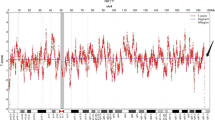Summary
About half of the cases of Angelman syndrome arise from deletions of chromosome band 15q12. In 25 cases we have been able to determine the parental origin of the deletion and, in line with other reported cases, we have found the deletion to be of maternal origin. There were no exceptions. The parental origin was determined using cytogenetic markers in 13 of the cases, in nine by using the pattern of inheritance of restriction fragment length polymorphisms, and in three using both techniques.
Similar content being viewed by others

References
Angelman H (1965) “Puppet” children: a report on three cases. Dev Med Child Neurol 7:681–683
Bloom SE, Goodpasture C (1976) An improved technique for selective silver staining of nucleolar organiser regions in human chromosomes. Hum Genet 34:199–206
Butler MG (1990) Prader-Willi syndrome: current understanding of cause and diagnosis. Am J Med Genet 35:319–332
Butler MG, Palmer CG (1983) Parental origin of chromosome 15 deletion in Prader-Willi syndrome. Lancet 1:1285–1286
Donlon TA (1988) Similar molecular deletions on chromosome 15q11. 2 are encountered in both Prader-Willi and Angelman syndrome. Hum Genet 80:322–328
Jeanpierre M (1987) A rapid method of purification of DNA from blood. Nucleic Acids Res 15:9611
Knoll JHM, Nicholls RD, Magenis RE, Graham JM, Lalande M, Latt SA (1989) Angelman and Prader-Willi syndromes share a common chromosome 15 deletion but differ in parental origin of the deletion. Am J Med Genet 32:285–290
Knoll JHM, Nicholls RD, Magenis RE, Glatt K, Graham J, Kaplan L, Lalande M (1990) Angelman syndrome: three molecular classes identified with chromosome 15q11q13 specific DNA markers. Am J Hum Genet 47:149–155
Magenis RE, Brown MG, Lacy DA, Budden S, Le Franchi S (1987) Is Angelman syndrome an alternate result of del(15) (q11q13)? Am J Med Genet 28:829–838
Magenis RE, Toth-Fejel S, Allen LJ, Black M, Brown MG, Budden S, Cohen R, Friedman JM, Kalousek D, Zonana J, Lacy D, La Franchi S, Lahr M, Macfarlane J, Williams CPS (1990) Comparison of the 15q deletions in Prader-Willi and Angelman syndromes. Am J Med Genet 35:333–349
Nicholls RD, Knoll JH, Glatt K, Hersh JH, Brewster TD, Graham JM, Wurster-Hill D, Wharton R, Latt SA (1989a) Restriction fragment length polymorphisms within proximal 15q and their use in molecular cytogenetics and the Prader-Willi syndrome. m J Med Genet 33:66–77
Pembrey ME, Fennell SJ, Van Den Berghe JA, Fitchett M, Summers D, Butler L, Clarke C, Griffiths M, Thompson E, Super M, Baraitser M (1989) The association of Angelman's syndrome with deletions within 15q11–13. J Med Genet 26:73–77
Author information
Authors and Affiliations
Rights and permissions
About this article
Cite this article
Smith, J.C., Webb, T., Pembrey, M.E. et al. Maternal origin of deletion 15q11–13 in 25/25 cases of Angelman syndrome. Hum Genet 88, 376–378 (1992). https://doi.org/10.1007/BF00215668
Received:
Revised:
Issue Date:
DOI: https://doi.org/10.1007/BF00215668



